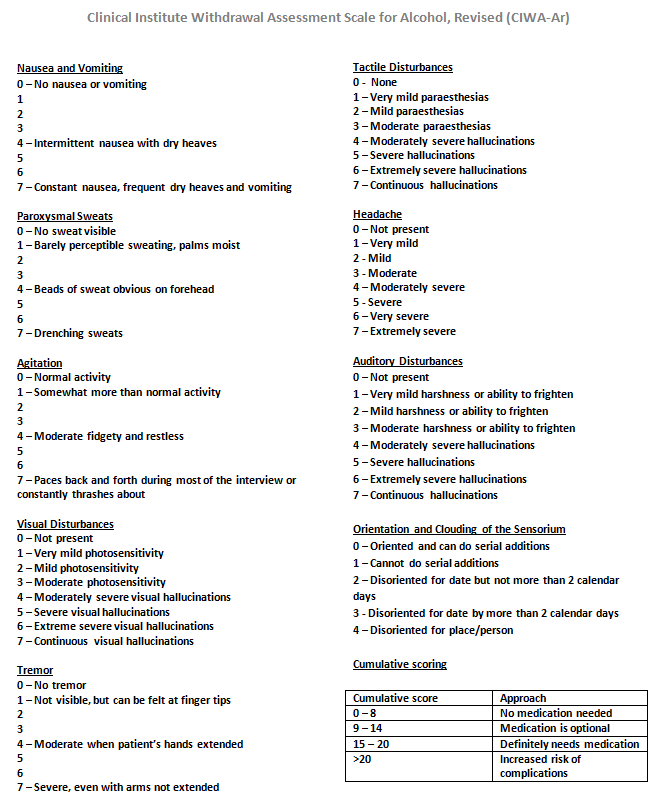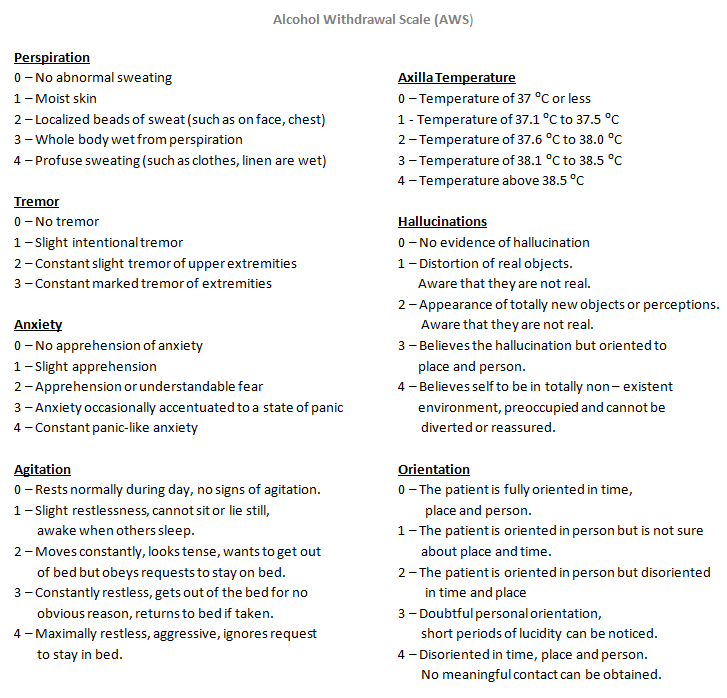Alcohol withdrawal diagnostic criteria: Difference between revisions
Kiran Singh (talk | contribs) No edit summary |
No edit summary |
||
| (4 intermediate revisions by 3 users not shown) | |||
| Line 7: | Line 7: | ||
{{CMG}}; {{AE}} {{ADI}}; {{KS}} | {{CMG}}; {{AE}} {{ADI}}; {{KS}} | ||
==Overview== | |||
The Diagnostic and Statistical Manual of Mental Disorders ([[DSM-5]]) criteria is used to diagnose [[alcohol]] withdrawal and the Clinical Institute Withdrawal Assessment for Alcohol (CIWA-A) scale is used to assess the severity of [[alcohol]] withdrawal. | |||
==Diagnosis== | ==Diagnosis== | ||
===Diagnostic Criteria=== | ===Diagnostic Criteria=== | ||
===DSM-V Diagnostic Criteria for Alcohol Withdrawal | ===DSM-V Diagnostic Criteria for Alcohol Withdrawal<ref name=DSMV>{{cite book | title = Diagnostic and statistical manual of mental disorders : DSM-5 | publisher = American Psychiatric Association | location = Washington, D.C | year = 2013 | isbn = 0890425558 }}</ref>==={{cquote| | ||
{{cquote| | |||
*A.Cessation of (or reduction in) alcohol use that has been heavy and prolonged. | *A. Cessation of (or reduction in) alcohol use that has been heavy and prolonged. | ||
'''''AND''''' | '''''AND''''' | ||
*B.Two (or more) of the following, developing within several hours to a few days after the cessation of (or reduction in) alcohol use described in Criterion A: | *B. Two (or more) of the following, developing within several hours to a few days after the cessation of (or reduction in) alcohol use described in Criterion A: | ||
:*1.Autonomic hyperactivity (e.g., sweating or pulse rate greater than 100 bpm). | :*1. Autonomic hyperactivity (e.g., sweating or pulse rate greater than 100 bpm). | ||
:*2.Increased hand tremor. | :*2. Increased hand tremor. | ||
:*3.[[Insomnia]]. | :*3. [[Insomnia]]. | ||
:*4.Nausea or | :*4. Nausea or vomiting. | ||
:*5.Transient visual, tactile, or [[auditory hallucinations]] or | :*5. Transient visual, tactile, or [[auditory hallucinations]] or illusions. | ||
:*6.[[Psychomotor agitation]]. | :*6. [[Psychomotor agitation]]. | ||
:*7.[[Anxiety]]. | :*7. [[Anxiety]]. | ||
:*8.Generalized tonic-clonic seizures. | :*8. Generalized tonic-clonic seizures. | ||
'''''AND''''' | '''''AND''''' | ||
*C.The signs or symptoms in Criterion B cause clinically significant distress or impairment in social, occupational, or other important areas of functioning. | *C. The signs or symptoms in Criterion B cause clinically significant distress or impairment in social, occupational, or other important areas of functioning. | ||
'''''AND''''' | '''''AND''''' | ||
*D.The signs or symptoms are not attributable to another medical condition and are not better explained by another mental disorder, including intoxication or withdrawal from | *D. The signs or symptoms are not attributable to another medical condition and are not better explained by another mental disorder, including intoxication or withdrawal from | ||
another substance. | another substance. | ||
Specify if: | Specify if: | ||
*With perceptual disturbances: This specifier applies in the rare instance when [[hallucinations]](usually visual or tactile) occur with intact reality testing, or auditory, visual, | * With perceptual disturbances: This specifier applies in the rare instance when [[hallucinations]](usually visual or tactile) occur with intact reality testing, or auditory, visual, | ||
}} | }} | ||
=== Clinical Institute Withdrawal Assessment for Alcohol revised (CIWA-Ar) === | === Clinical Institute Withdrawal Assessment for Alcohol revised (CIWA-Ar) === | ||
| Line 80: | Line 74: | ||
[[Category:Toxicology]] | [[Category:Toxicology]] | ||
[[Category:Intensive care medicine]] | [[Category:Intensive care medicine]] | ||
[[Category:DSM-V Diagnostic Criteria]] | |||
[[Category:Psychiatric Disease]] | |||
[[Category:Psychiatry]] | |||
Latest revision as of 17:10, 12 November 2020
| Resident Survival Guide |
|
Alcohol Withdrawal Microchapters |
|
Diagnosis |
|---|
|
Treatment |
|
Case Studies |
|
Alcohol withdrawal diagnostic criteria On the Web |
|
American Roentgen Ray Society Images of Alcohol withdrawal diagnostic criteria |
|
Risk calculators and risk factors for Alcohol withdrawal diagnostic criteria |
For patient information click here.
Editor-In-Chief: C. Michael Gibson, M.S., M.D. [1]; Associate Editor(s)-in-Chief: Aditya Govindavarjhulla, M.B.B.S. [2]; Kiran Singh, M.D. [3]
Overview
The Diagnostic and Statistical Manual of Mental Disorders (DSM-5) criteria is used to diagnose alcohol withdrawal and the Clinical Institute Withdrawal Assessment for Alcohol (CIWA-A) scale is used to assess the severity of alcohol withdrawal.
Diagnosis
Diagnostic Criteria
DSM-V Diagnostic Criteria for Alcohol Withdrawal[1]
| “ |
AND
AND
AND
another substance. Specify if:
|
” |
Clinical Institute Withdrawal Assessment for Alcohol revised (CIWA-Ar)
The CIWA (Clinical Institute Withdrawal Assessment)[2] is a common measure used in North American hospitals to assess and treat alcohol withdrawal syndrome and for alcohol detoxification. This clinical tool assesses 10 common withdrawal signs.[3] A score of more than 15 points is associated with increased risk of alcohol withdrawal effects such as confusion or seizures.

Other Assessment Scales
- Alcohol Assessment Scale

Level of Evidence
| Assessment Scale | Level of Evidence |
| The Clinical Institute Withdrawal Assessment for Alcohol Revised (CIWA-Ar) | I |
| Alcohol Assessment Scale (AWS) | IV |
References
- ↑ Diagnostic and statistical manual of mental disorders : DSM-5. Washington, D.C: American Psychiatric Association. 2013. ISBN 0890425558.
- ↑ Puz CA, Stokes SJ (2005). "Alcohol withdrawal syndrome: assessment and treatment with the use of the Clinical Institute Withdrawal Assessment for Alcohol-revised". Crit Care Nurs Clin North Am. 17 (3): 297–304. doi:10.1016/j.ccell.2005.04.001. PMID 16115538. Unknown parameter
|month=ignored (help) - ↑ McKay A, Koranda A, Axen D (2004). "Using a symptom-triggered approach to manage patients in acute alcohol withdrawal". Medsurg Nurs. 13 (1): 15–20, 31, quiz 21. PMID 15029927. Unknown parameter
|month=ignored (help)